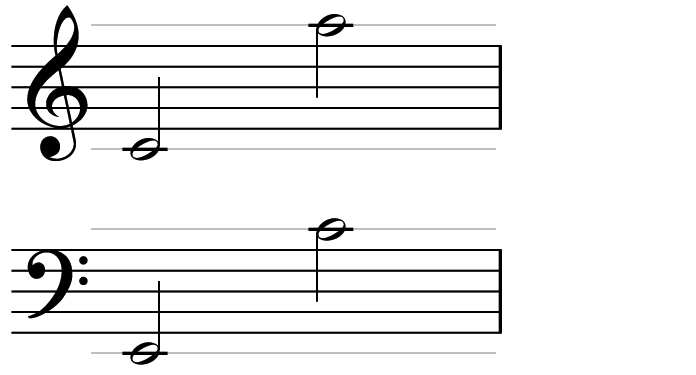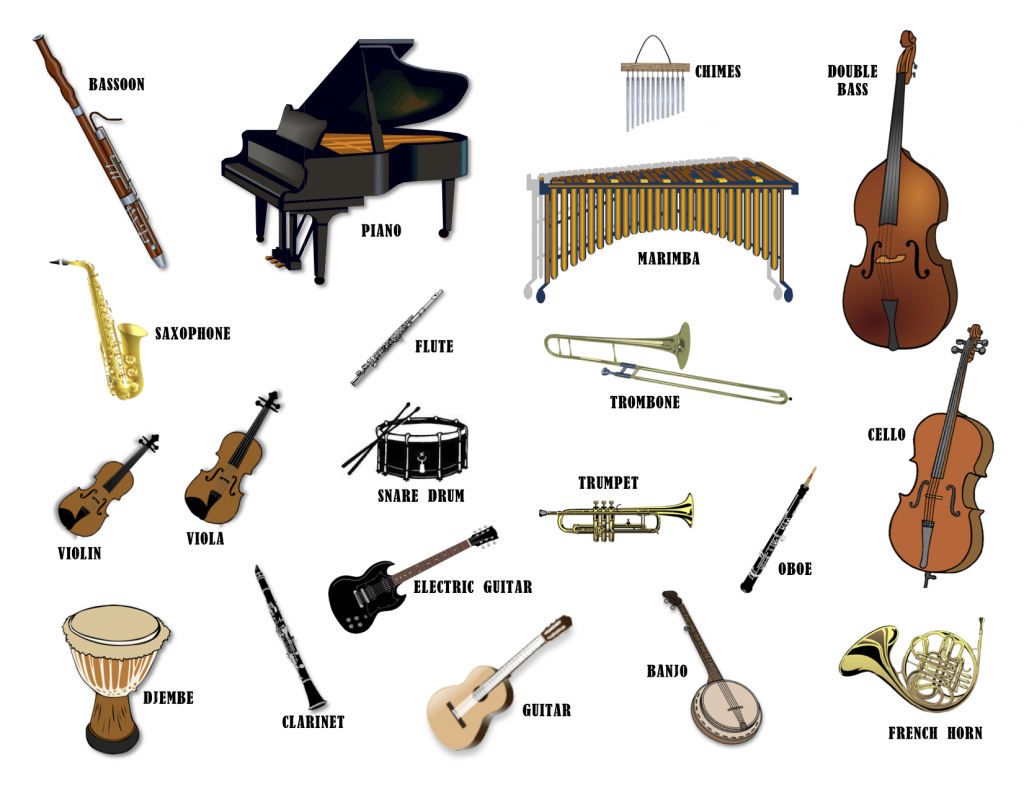If you want to download it CLICK HERE!
1. SOUND, NOISE AND SILENCE
 Essentially, music is sound. SOUND is produced when an object vibrates and it is what can be perceived by througha través de its sense of hearingsentido del oído. It travels through PHYSICAL MEDIUMS by sound wavespor ondas sonoras and it is normally a pleasant feelingsensación agradable. Sound propagates at high speeds. The waves travel through the air at 340 meters per second.
Essentially, music is sound. SOUND is produced when an object vibrates and it is what can be perceived by througha través de its sense of hearingsentido del oído. It travels through PHYSICAL MEDIUMS by sound wavespor ondas sonoras and it is normally a pleasant feelingsensación agradable. Sound propagates at high speeds. The waves travel through the air at 340 meters per second. NOISE is a disagreeable auditory experiencesensación auditiva desagradable but this is a subjectiveAnywayen cualquier caso, the physical difference between sound and noise is the sort of wavesel tipo de ondas: sound waves are regular and in a noise the wave is irregular (look at the pictures in your book).
NOISE is a disagreeable auditory experiencesensación auditiva desagradable but this is a subjectiveAnywayen cualquier caso, the physical difference between sound and noise is the sort of wavesel tipo de ondas: sound waves are regular and in a noise the wave is irregular (look at the pictures in your book).definition (for instance, most of the percussion instruments produce noises when they are played).
Finally, SILENCE is the lack of hearing sensationausencia de sensación auditiva. Actually, there isn´t such thing as absolute silence. Even if we could isolateaislar our selves completely from outer sounds, we would still hear our own body´s inner sounds.
2. QUALITIES OF SOUND
There are 4 basic qualities:
PITCHaltura (Hz) Low sound/High sound
DURATION (Sec.) Short sound/Long sound
INTENSITY (dB) Forte/Piano
TIMBRE (Harmonics) What kindtipo of sound?
2.1. PITCH
 This is the the characteristic of sound that tells us the difference between a high sound and a low sound. It depends on the wave frequency: the vibration speed. It is measured in units called hertzes (Hz) which show the number of vibrations per second. To represent the pitch we use the staff, the clef and the notes. The staff is written as five horizontal parallel lines. Most ofla mayoría de the notes of the music are placed onsituadas one of these lines or in a space between lines. Extra ledger lines may be addedlíneas adicionales extra deben ser añadidas to show a note that is too high or too low to be on the staff.
This is the the characteristic of sound that tells us the difference between a high sound and a low sound. It depends on the wave frequency: the vibration speed. It is measured in units called hertzes (Hz) which show the number of vibrations per second. To represent the pitch we use the staff, the clef and the notes. The staff is written as five horizontal parallel lines. Most ofla mayoría de the notes of the music are placed onsituadas one of these lines or in a space between lines. Extra ledger lines may be addedlíneas adicionales extra deben ser añadidas to show a note that is too high or too low to be on the staff.The clefLa clave is the symbol at the beginning of the staff. It indicates the name that the notes are going to receive. The treble clefLa clave de sol indicates that the note on the 2nd line is called G (sol). From that reference, we can deduct the names of the rest of the notes on the staff.
2.2. DURATION
 This is the characteristic of sound that tells us the difference between a short sound and a long sound. It depends on the wave persistencela permanencia de la onda: how long de wave lasts until to fade outapagarse.
This is the characteristic of sound that tells us the difference between a short sound and a long sound. It depends on the wave persistencela permanencia de la onda: how long de wave lasts until to fade outapagarse.
The duration of a sound is indicated using several symbols. In standard notation, a single musical sound is written as a note.
- Note length modifiers
They are used to prolong or extend the duration of notes and rests. We have three note length modifiers:
* DotPuntillo: it is a small dot placed on the right of notes and rests. It adds half of their value. Therefore, the length of the dot depends on the note value it goes with.
* LigatureLigadura: it is curved line that links two or more notes that sound the same, adding up their lengths.
* FermataCalderón: it is a semicircle with a dot in the middle. It extends the length of the note or rest, interrupting for a moment the time measure.
2.3. INSTENSITY
 This is the the characteristic of sound that tells us the difference between a loud sound and a soft soundsonido fuerte y sonido suave. It depends on the wave amplitude, the distance between the points of highest vibration and repose of the object. It is measured in units called decibels (dB). Dynamics are the loudness or softness of a composition. The term piano (p) is used to indicate softnesssuavidad and forte (f) to indicate loudnessfuerza (en volumen). Each of these is augmentedaumentada if the letter symbolizing it is doubled or tripled (e.g. "pp" - "pianissimo", "very soft"; "ppp" - "pianississimo", "very, very soft"). Each one is also lesseneddisminuida if proceeded by mezzo (m) (e.g. "mf" - "mezzo forte", "somewhat loud").
This is the the characteristic of sound that tells us the difference between a loud sound and a soft soundsonido fuerte y sonido suave. It depends on the wave amplitude, the distance between the points of highest vibration and repose of the object. It is measured in units called decibels (dB). Dynamics are the loudness or softness of a composition. The term piano (p) is used to indicate softnesssuavidad and forte (f) to indicate loudnessfuerza (en volumen). Each of these is augmentedaumentada if the letter symbolizing it is doubled or tripled (e.g. "pp" - "pianissimo", "very soft"; "ppp" - "pianississimo", "very, very soft"). Each one is also lesseneddisminuida if proceeded by mezzo (m) (e.g. "mf" - "mezzo forte", "somewhat loud").
Also included in dynamics are the crescendo (gradually increasing intensity), decrescendo (gradually decreasing intensity) and the sforzando (sudden loudness).
There are some V-shaped symbols, called hairpinsreguladores, which represent a gradual or progressive intensity change.
2.4. TIMBRE
 One of the basic elements of music is called color, or timbre. Timbre describes all of the aspects of a musical by the factpor el hecho that each note from a musical instrument is a complex waveonda compleja containing more than one frequency. For instruments that produce notes with a clear and specific pitch, the secondary frequencies that are involvedinvolucrados in the sound are called harmonicsharmónicos. The human ear and brain are capable of hearing and appreciating very small variations in timbre. Another approach would make possibleOtra aproximación haría posible to look at and to touch music. You could refer to the colour of a given sound (light or dark), to its brightness (glossy or mattbrillante o mate) and to its touch (smooth or roughsuave o rugoso), its weight (heavy or light), its width (wide or narrowancho o delgado), its consistency (soft or toughblando o duro) and its temperature (warm or cold).
One of the basic elements of music is called color, or timbre. Timbre describes all of the aspects of a musical by the factpor el hecho that each note from a musical instrument is a complex waveonda compleja containing more than one frequency. For instruments that produce notes with a clear and specific pitch, the secondary frequencies that are involvedinvolucrados in the sound are called harmonicsharmónicos. The human ear and brain are capable of hearing and appreciating very small variations in timbre. Another approach would make possibleOtra aproximación haría posible to look at and to touch music. You could refer to the colour of a given sound (light or dark), to its brightness (glossy or mattbrillante o mate) and to its touch (smooth or roughsuave o rugoso), its weight (heavy or light), its width (wide or narrowancho o delgado), its consistency (soft or toughblando o duro) and its temperature (warm or cold).PRACTICE
Pangea
ACTIVITIES
To sum up...





